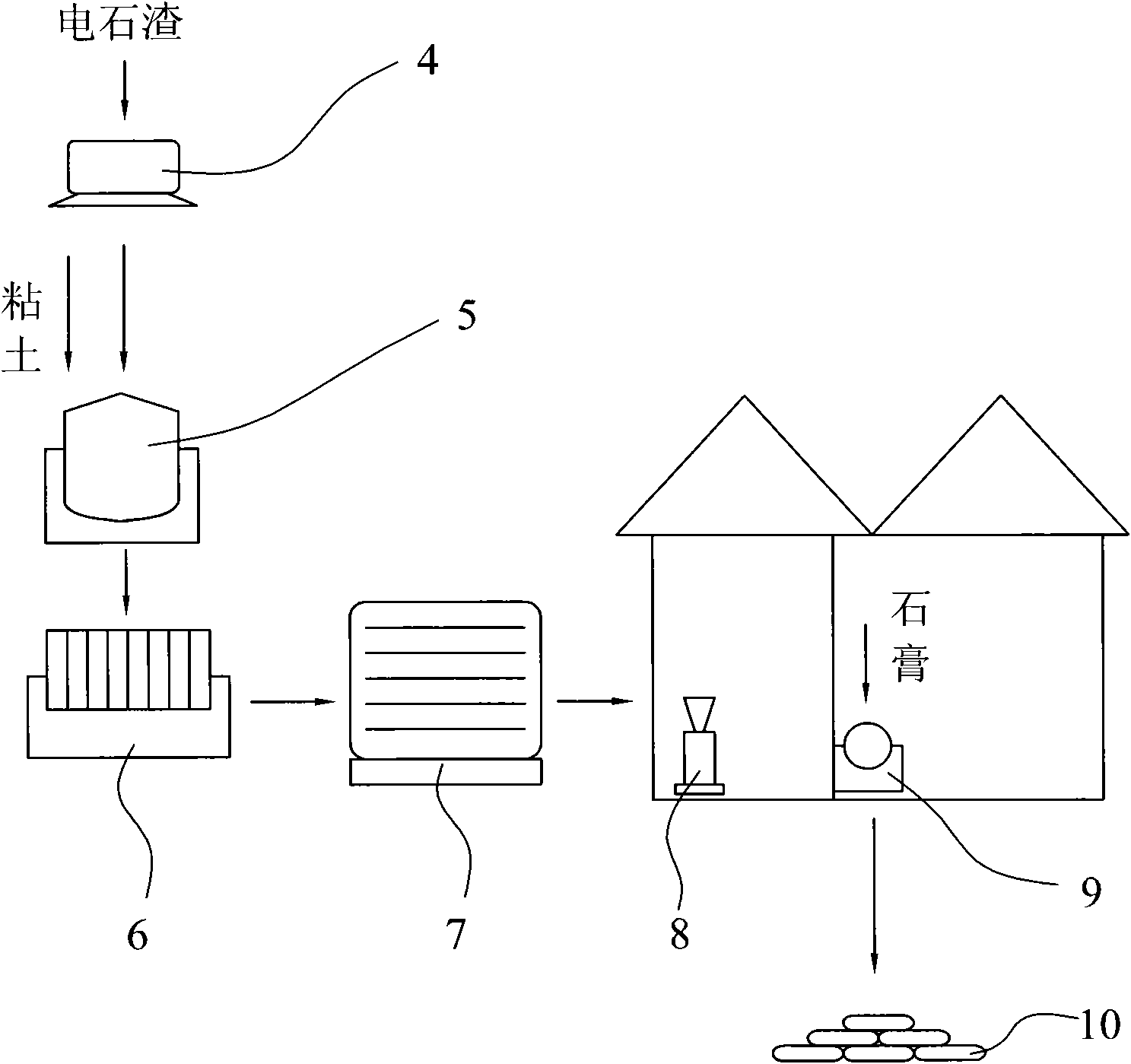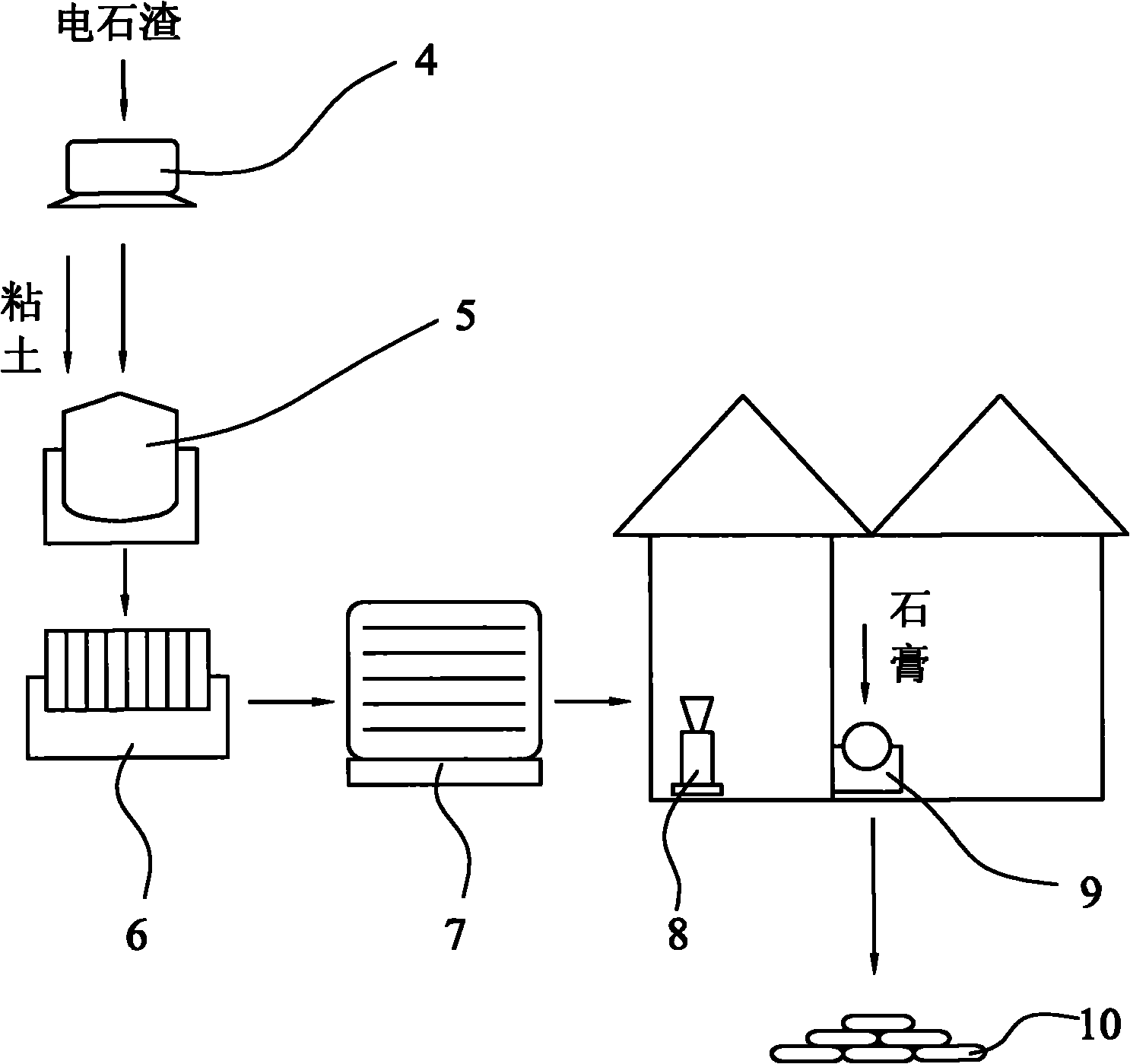Method for producing cement by using waste residue generated by polyvinyl chloride by calcium carbide method
A technology of polyvinyl chloride and carbide slag, applied in cement production, etc., can solve problems such as unsuitable for large-scale promotion and application, cumbersome and complicated operation, high equipment requirements, etc., and achieve low production cost, low equipment investment, and environmental protection.
- Summary
- Abstract
- Description
- Claims
- Application Information
AI Technical Summary
Problems solved by technology
Method used
Image
Examples
Embodiment 1
[0021] refer to figure 1 , the 693.75kg calcium carbide slag produced by calcium carbide method polyvinyl chloride is centrifuged in the centrifuge (4), the water content of the calcium carbide slag is controlled at 20%, and then the calcium carbide slag and clay are dropped into according to the ratio of 1: 0.3 according to the mass ratio Stir evenly in the mixing mixer (5), then use the blank forming machine (6) to press into blanks, put them into the calciner (7), and calcinate at 550°C to make calcium carbide slag and clay dehydrate and decompose into oxidized The mixture I of calcium, silicon oxide, aluminum and iron is cooled after coming out of the furnace, and is pulverized into 60 mm lumps with a pulverizer (8), then mixes with the raw gypsum of mixture I quality 4%, enters a ball mill (9) and grinds into 750 The purpose fine powder is then bagged, weighed, and packed to obtain the finished cement product (10) of 790.875kg.
[0022] Embodiment two:
Embodiment 2
[0024] refer to figure 1 , the 693.75kg calcium carbide slag produced by the calcium carbide process polyvinyl chloride is centrifuged in the centrifuge (4), the water content of the calcium carbide slag is controlled at 40%, and then the calcium carbide slag and clay are dropped into according to the ratio of 1: 0.45 according to the mass ratio Stir evenly in the mixing mixer (5), and then use the blank forming machine (6) to press into a blank, put it in the calciner (7), and calcinate at 650°C to remove moisture from the calcium carbide slag and clay, and decompose them into oxidized The mixture I of calcium, silicon oxide, aluminum and iron is cooled after coming out of the furnace, and is pulverized into 80 mm lumps with pulverizer (8), then mixes with the raw gypsum of mixture I quality 6%, enters ball mill (9) and grinds into 750 The purpose fine powder is then bagged, weighed, and packed to obtain the finished cement product (10) of 770.065kg.
[0025] Embodiment thre...
Embodiment 3
[0027] refer to figure 1 , the 693.75kg calcium carbide slag produced by the calcium carbide process polyvinyl chloride is centrifuged in the centrifuge (4), the water content of the calcium carbide slag is controlled at 30%, and then the calcium carbide slag and clay are dropped into according to the ratio of 1: 0.6 according to the mass ratio Stir evenly in the mixing mixer (5), then use the blank forming machine (6) to press into blanks, put them into the calciner (7), and calcinate at 600°C to remove moisture from the calcium carbide slag and clay, and decompose them into oxidized The mixture I of calcium, silicon oxide, aluminum and iron is cooled after coming out of the furnace, and is pulverized into 100 mm lumps with a pulverizer (8), then mixes with the raw gypsum of mixture I quality 8%, enters the ball mill (9) and grinds into 750 The purpose fine powder is then bagged, weighed, and packed to obtain the finished cement product (10) of 957.375kg.
[0028] The above-...
PUM
 Login to View More
Login to View More Abstract
Description
Claims
Application Information
 Login to View More
Login to View More - R&D Engineer
- R&D Manager
- IP Professional
- Industry Leading Data Capabilities
- Powerful AI technology
- Patent DNA Extraction
Browse by: Latest US Patents, China's latest patents, Technical Efficacy Thesaurus, Application Domain, Technology Topic, Popular Technical Reports.
© 2024 PatSnap. All rights reserved.Legal|Privacy policy|Modern Slavery Act Transparency Statement|Sitemap|About US| Contact US: help@patsnap.com









